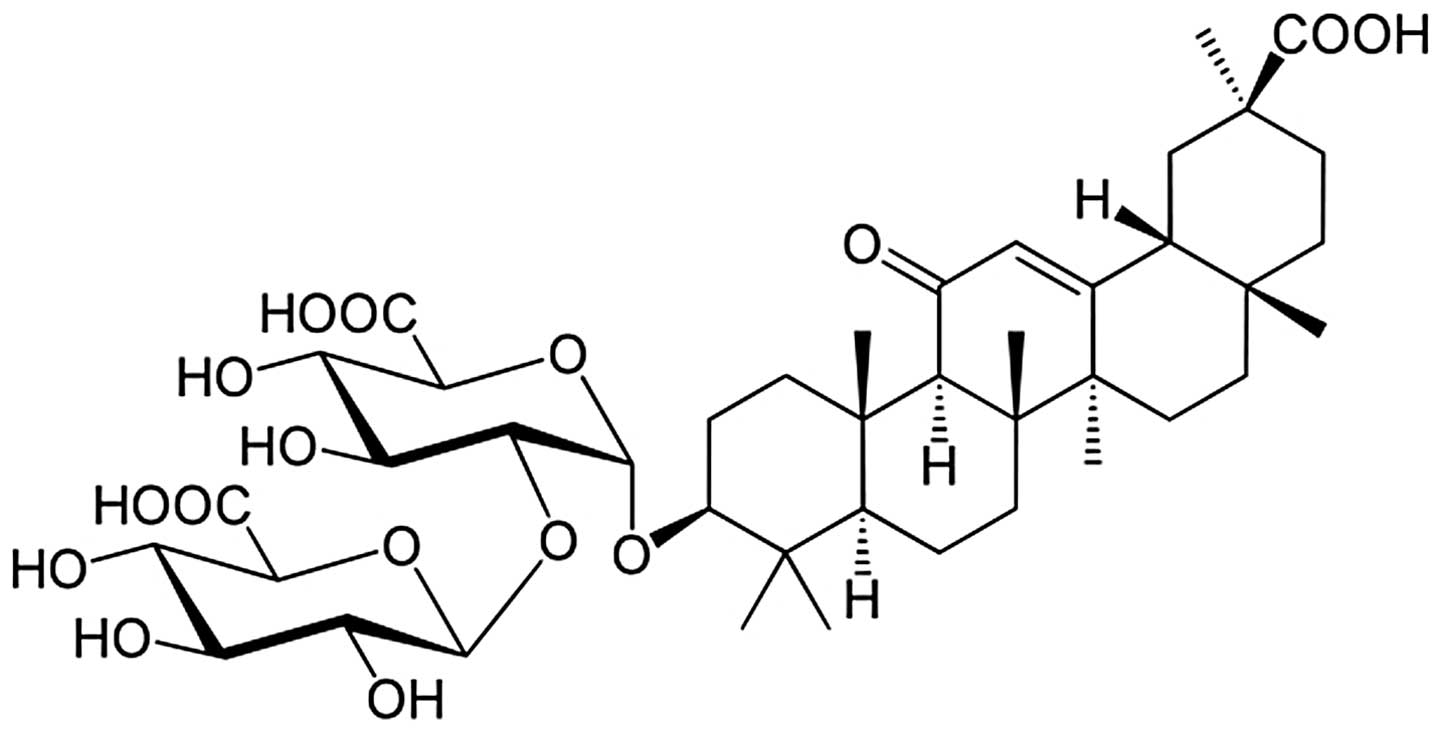|
1
|
Cinatl J, Morgenstern B, Bauer G, Chandra
P, Rabenau H and Doerr HW: Glycyrrhizin, an active component of
liquorice roots, and replication of SARS-associated coronavirus.
Lancet. 361:2045–2046. 2003. View Article : Google Scholar : PubMed/NCBI
|
|
2
|
Dhiman RK and Chawla YK: Herbal medicines
for liver diseases. Dig Dis Sci. 50:1807–1812. 2005. View Article : Google Scholar : PubMed/NCBI
|
|
3
|
Kim SC, Byun SH, Yang CH, Kim CY, Kim JW
and Kim SG: Cytoprotective effects of Glycyrrhizae radix extract
and its active component liquiritigenin against cadmium-induced
toxicity (effects on bad translocation and cytochrome c-mediated
PARP cleavage). Toxicology. 197:239–251. 2004. View Article : Google Scholar
|
|
4
|
Jo EH, Kim SH, Ra JC, Kim SR, Cho SD, Jung
JW, et al: Chemopreventive properties of the ethanol extract of
Chinese licorice (Glycyrrhiza uralensis) root: induction of
apoptosis and G1 cell cycle arrest in MCF-7 human breast cancer
cells. Cancer Lett. 230:239–247. 2005.PubMed/NCBI
|
|
5
|
Yuan H, Ji WS, Wu KX, Jiao JX, Sun LH and
Feng YT: Anti-inflammatory effect of Diammonium Glycyrrhizinate in
a rat model of ulcerative colitis. World J Gastroenterol.
12:4578–4581. 2006.PubMed/NCBI
|
|
6
|
Kim SW, Jin Y, Shin JH, Kim ID, Lee HK,
Park S, Han PL and Lee JK: Glycyrrhizic acid affords robust
neuroprotection in the postischemic brain via anti-inflammatory
effect by inhibiting HMGB1 phosphorylation and secretion. Neurobiol
Dis. 46:147–156. 2012. View Article : Google Scholar : PubMed/NCBI
|
|
7
|
Gong G, Yuan LB, Hu L, Wu W, Yin L, Hou
JL, Liu YH and Zhou LS: Glycyrrhizin attenuates rat ischemic spinal
cord injury by suppressing inflammatory cytokines and HMGB1. Acta
Pharmacol Sin. 33:11–18. 2012. View Article : Google Scholar : PubMed/NCBI
|
|
8
|
Hwang IK, Lim SS, Choi KH, Yoo KY, Shin
HK, Kim EJ, et al: Neuroprotective effects of roasted licorice, not
raw form, on neuronal injury in gerbil hippocampus after transient
forebrain ischemia. Acta Pharmacol Sin. 27:959–965. 2006.
View Article : Google Scholar
|
|
9
|
Ohnishi M, Katsuki H, Fukutomi C,
Takahashi M, Motomura M, Fukunaga M, et al: HMGB1 inhibitor
glycyrrhizin attenuates intracerebral hemorrhage-induced injury in
rats. Neuropharmacology. 61:975–980. 2011. View Article : Google Scholar : PubMed/NCBI
|
|
10
|
Ogiku M, Kono H, Hara M, Tsuchiya M and
Fujii H: Glycyrrhizin prevents liver injury by inhibition of
high-mobility group box 1 production by Kupffer cells after
ischemia-reperfusion in rats. J Pharmcol Exp Ther. 339:93–98. 2011.
View Article : Google Scholar : PubMed/NCBI
|
|
11
|
van Rossum TG, Vulto AG, Hop WC and Schalm
SW: Glycyrrhizin-induced reduction of ALT in European patients with
chronic hepatitis C. Am J Gastroenterol. 96:2432–2437.
2001.PubMed/NCBI
|
|
12
|
Kumada H: Long-term treatment of chronic
hepatitis C with glycyrrhizin [stronger neo-minophagen C (SNMC)]
for preventing liver cirrhosis and hepatocellular carcinoma.
Oncology. 62(Suppl 1): 94–100. 2002.
|
|
13
|
Majdan M, Lachance C, Gloster A, Aloyz R,
Zeindler C, Bamji S, et al: Transgenic mice expressing the
intracellular domain of the p75 neurotrophin receptor undergo
neuronal apoptosis. J Neurosci. 17:6988–6998. 1997.PubMed/NCBI
|
|
14
|
Frade JM and Barde YA: Genetic evidence
for cell death mediated by nerve growth factor and the neurotrophin
receptor p75 in the developing mouse retina and spinal cord.
Development. 126:683–690. 1999.PubMed/NCBI
|
|
15
|
Harada C, Harada T, Nakamura K, Sakai Y,
Tanaka K and Parada LF: Effect of p75NTR on the regulation of
naturally occurring cell death and retinal ganglion cell number in
the mouse eye. Dev Biol. 290:57–65. 2006. View Article : Google Scholar : PubMed/NCBI
|
|
16
|
Jansen P, Giehl K, Nyengaard JR, Teng K,
Lioubinski O, Sjoegaard SS, et al: Roles for the pro-neurotrophin
receptor sortilin in neuronal development, aging and brain injury.
Nat Neurosci. 10:1449–1457. 2007. View
Article : Google Scholar : PubMed/NCBI
|
|
17
|
Paul CE, Vereker E, Dickson KM and Barker
PA: A pro-apoptotic fragment of the p75 neurotrophin receptor is
expressed in p75NTRExonIV null mice. J Neurosci. 24:1917–1923.
2004. View Article : Google Scholar : PubMed/NCBI
|
|
18
|
Küst B, Mantingh-Otter I, Boddeke E and
Copray S: Deficient p75 low-affinity neurotrophin receptor
expression does alter the composition of cellular infiltrate in
experimental autoimmune encephalomyelitis in C57BL/6 mice. J
Neuroimmunol. 174:92–100. 2006.
|
|
19
|
Du JS, Zhao Q, Zhang YL, Wang Y and Ma M:
7,8-dihydroxycoumarin may promote sciatic nerve regeneration by
suppressing NF-κB expression in mice. Mol Med Rep. 8:1525–1530.
2013.PubMed/NCBI
|
|
20
|
Cao J, Jiang YW, Sun Y, Zhang XZ, Li LS
and Man Y-H: Immunosuppression of NF-κB by intragastric brazilein
in motor neuron of spinal cord connected with injured sciatic nerve
in mouse. Biomed Res (India). 23:199–206. 2012.
|
|
21
|
Marsland TA, Glees P and Erikson LB:
Modification of the Glees silver impregnation for paraffin
sections. J Neuropathol Exp Neurol. 13:587–591. 1954. View Article : Google Scholar : PubMed/NCBI
|
|
22
|
Zhang XH and Chen JJ: The mechanism of
astragaloside IV promoting sciatic nerve regeneration. Neural Regen
Res. 8:2256–2265. 2013.PubMed/NCBI
|
|
23
|
Timperley WR: ACP Best Practice No 158.
Neuropathology J Clin Pathol. 53:255–265. 2000.PubMed/NCBI
|
|
24
|
Bunge MB, Bunge RP and Ris H:
Ultrastructural study of remyelination in an experimental lesion in
adult cat spinal cord. J Biophys Biochem Cytol. 10:67–94. 1961.
View Article : Google Scholar
|
|
25
|
Smith ME and Eng LF: Glial fibrillary
acidic protein in chronic relapsing experimental allergic
encephalomyelitis in SJL/J mice. J Neurosci Res. 18:203–208. 1987.
View Article : Google Scholar : PubMed/NCBI
|
|
26
|
Yokobori S, Hosein K, Burks S, Sharma I,
Gajavelli S and Bullock R: Biomarkers for the clinical differential
diagnosis in traumatic brain injury - systematic review. CNS
Neurosci Ther. 19:556–565. 2013. View Article : Google Scholar
|













